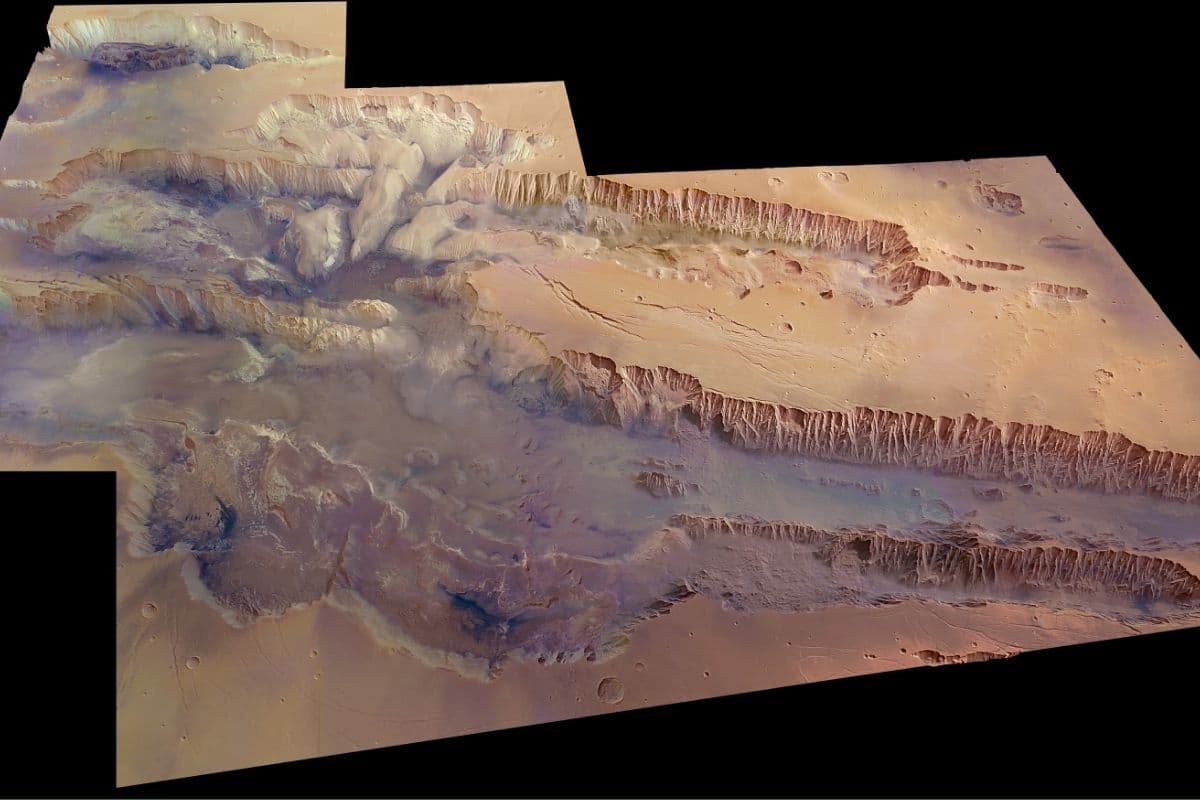
The wetland area is about the size of the Netherlands and a promising place for future reconnaissance missions.
On the red planet we find a huge canyon system called Valles Marineris. This system is also known as the Grand Canyon of Mars. Researchers now come in a new study to a surprising discovery. Because exactly under Valles Marineris a considerable amount of water appears to be hidden.
Water on Mars
Although Mars today is a dry and arid place, we have known for some time that water can still be found on the red planet. Most of the water is in the form of ice caps at the poles. Still, scientists suspect that underground lakes may also exist on Mars. So scientists set out to search using ESA’s Trace Gas Orbiter. “With TGO, we can see a meter below the dusty soil layer and see what is really happening below the Martian surface,” said researcher Igor Mitrofanov. “That way we can locate wetland ‘oases’ that could not be detected with previous instruments.”
Valles Marineris
Using FREND – an instrument on board the TGO that measures the hydrogen content in the soil – the researchers scanned the Martian soil. And that leads to a surprising discovery. It seems that there is a significant amount of water under Valles Marineris.

The newly discovered wetland area under Valles Marineris, the size of the Netherlands. Image: I. Mitrofanov et al. (2021)
“FREND revealed an area with an unusually large amount of hydrogen in the colossal canyon system,” Mitrofanov said. The wetland area is about the same size as the Netherlands. And that means that it is a decent water reservoir. “We found much more water than we expected,” added researcher Alexey Malakhov. “It’s very similar to the permafrost areas on Earth, where water ice is permanently trapped under the dry ground due to the constant low temperatures.”
Form
The exact shape of the water is currently unknown. For example, the water can be in the form of ice, although it can also be chemically bound to other minerals in the soil. “However, we suspect that this is ice,” said Malakhov. However, water ice usually evaporates in this area of Mars due to the temperature and pressure near the equator. The same applies to chemically bound water. The fact that traces of water have now been found under Valles Marineris suggests that an as yet unclear combination of circumstances ensures that water is preserved here – or that it is replenished in some way. “The current findings are a great first step,” said researcher Håkan Svedhem. “But we need more observations to know for sure what form of water we are dealing with here.”
Future Reconnaissance Missions
The discovery that there may be a real water reservoir under Valles Marineris makes this area a very interesting place for future reconnaissance missions. “By learning more about how and where water still exists on what is now Mars, we may also be able to figure out what happened to all the water that once flowed liberally over the red planet,” said study researcher Collin Wilson. “In addition, it helps us in our search for habitable environments, possibly signs of former life and organic materials from the earliest days of Mars.”
TGO was launched in 2016 as part of the EXOMars program. The orbiter will be joined in 2022 by the European rover Rosalind Franklin and the Russian Marslander Kazachok. Rosalind the rover will search six feet below the surface for traces of life forms that lived on Mars long ago, or may have survived to this day. Kozachok will remain in one place to investigate the climate, atmosphere and possible presence of subsurface water at the landing site. Ultimately, the goal is to better understand whether life ever existed on Mars.
Source material:
“ExoMars discovers hidden water in Mars’ Grand Canyon” –
Image at the top of this article: ESA/DLR/FU Berlin (G. Neukum), CC BY-SA 3.0 IGO